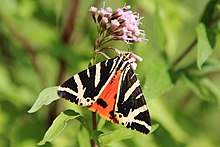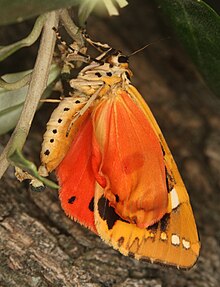Euplagia quadripunctaria
| Jersey tiger | |
|---|---|
 | |
 | |
Scientific classification | |
| Kingdom: | Animalia |
| Phylum: | Euarthropoda |
| Class: | Insecta |
| Order: | Lepidoptera |
| Superfamily: | Noctuoidea |
| Family: | Erebidae |
| Genus: | Euplagia |
| Species: | E. quadripunctaria |
Binomial name | |
Euplagia quadripunctaria (Poda, 1761) | |
Synonyms | |
| |
Euplagia quadripunctaria, the Jersey tiger, is a day-flying moth of the family Erebidae. The adult wingspan is 52–65 millimetres (2.0–2.6 in), and they fly from July to September, depending on the location.[1] They tend to fly close to Eupatorium cannabinum, where they are hard to notice because of their camouflage.[citation needed]
The larvae (caterpillars) are polyphagous, feeding from September to May on nettles (Urtica) and raspberries(Rubus),[2] dandelion (Taraxacum), white deadnettle (Lamium), ground ivy (Glechoma), groundsel (Senecio), plantain (Plantago), borage (Borago), lettuce (Lactuca),[3] and hemp-agrimony (Eupratoria).[1] The insect overwinters as a small larva.[1]
Large groups of adults of subspecies E. q. rhodosensis can be found on occasion aestivating (sheltering from the summer heat) in Petaloudes, on Rhodes, in a place that has become known as the 'Valley of the Butterflies'.[4]
Contents
1 Distribution
1.1 British Isles
2 Subspecies
3 References
4 Further reading
5 External links
Distribution
Euplagia quadripunctaria is widely distributed in Europe from Estonia and Latvia in the north to the Mediterranean coast and islands in the south.[3] It is also found in West Russia, South Urals, Asia Minor, Rhodes and nearby islands, the Near East, Caucasus, South Turkmenistan, and Iran (Dubatolov, 2010). Individuals are known to migrate northwards from their regular breeding grounds during the summer.[1]
British Isles
Aside from being frequent in the Channel Islands (whence its common name comes), this species was rarely seen in the British Isles in Victorian times.[3] It was described by Kirby as, "a great rarity in the South of England, except one locality in Devonshire."[2] Since then however it has spread more widely in Devon and Cornwall,[1] and has recently been seen more frequently in southern England, especially on the Isle of Wight, in northern Kent,[5] and south London.[6] They have been seen regularly and in numbers every year in London first discovered at Devonshire Road Nature Reserve in Forest Hill since 2004, so it is probable that they have established a breeding colony.[7]
Subspecies
Euplagia quadripunctaria quadripunctaria (Europe, Caucasus, Transcaucasus, northern Anatolia, northern Iran, southern Turkmenistan)
Euplagia quadripunctaria fulgida (South Turkey, Syria, Lebanon)
Euplagia quadripunctaria rhodosensis (Western Turkey and neighboring islands of Greece)
References
^ abcde Skinner B. (1984) Colour Identification Guide to Moths of the British Isles (Macrolepidoptera), Viking (Penguin Books), London: .mw-parser-output cite.citation{font-style:inherit}.mw-parser-output q{quotes:"""""""'""'"}.mw-parser-output code.cs1-code{color:inherit;background:inherit;border:inherit;padding:inherit}.mw-parser-output .cs1-lock-free a{background:url("//upload.wikimedia.org/wikipedia/commons/thumb/6/65/Lock-green.svg/9px-Lock-green.svg.png")no-repeat;background-position:right .1em center}.mw-parser-output .cs1-lock-limited a,.mw-parser-output .cs1-lock-registration a{background:url("//upload.wikimedia.org/wikipedia/commons/thumb/d/d6/Lock-gray-alt-2.svg/9px-Lock-gray-alt-2.svg.png")no-repeat;background-position:right .1em center}.mw-parser-output .cs1-lock-subscription a{background:url("//upload.wikimedia.org/wikipedia/commons/thumb/a/aa/Lock-red-alt-2.svg/9px-Lock-red-alt-2.svg.png")no-repeat;background-position:right .1em center}.mw-parser-output .cs1-subscription,.mw-parser-output .cs1-registration{color:#555}.mw-parser-output .cs1-subscription span,.mw-parser-output .cs1-registration span{border-bottom:1px dotted;cursor:help}.mw-parser-output .cs1-hidden-error{display:none;font-size:100%}.mw-parser-output .cs1-visible-error{font-size:100%}.mw-parser-output .cs1-subscription,.mw-parser-output .cs1-registration,.mw-parser-output .cs1-format{font-size:95%}.mw-parser-output .cs1-kern-left,.mw-parser-output .cs1-kern-wl-left{padding-left:0.2em}.mw-parser-output .cs1-kern-right,.mw-parser-output .cs1-kern-wl-right{padding-right:0.2em}
ISBN 0-670-80354-5
^ ab Kirby W.F. (1903) The Butterflies and Moths of Europe, Cassell & Co. Ltd., London: 432 pp.
^ abc South R. (1920) The Moths of the British Isles, (Series 1, Second edition), Frederick Warne & Co. Ltd., London: 359 pp.
^ Heath J. & Maitland Emmet A. (1985) The Moths and Butterflies of Great Britain and Ireland, Vol.2, Harley Books Ltd., Colchester:
ISBN 0-946589-02-X
^ Ferguson I.D. (2009) Kent Moth Report 2005, Butterfly Conservation, Kent Branch: 56 pp. Link to PDF
^ Sightings of Jersey tiger in Orpington, August 2012, at RSPB.org also in Streatham, London in July 2014.
^ Jersey tigers on UK Safari page
Further reading
.mw-parser-output .smallcaps{font-variant:small-caps}
Dubatolov, V.V., 2010: Tiger-moths of Eurasia (Lepidoptera, Arctiidae) (Nyctemerini by Rob de Vos & Vladimir V. Dubatolov). Neue Entomologische Nachrichten 65: 1-106.
Roesler, U., 1968: Panaxia quadripunctaria ssp. ingridae ssp.nov. (Lepidoptera, Arctiidae). Entomologische Zeitschrift 78 (24): 280-284, Stuttgart.
External links
| Wikimedia Commons has media related to Euplagia quadripunctaria. |
Wikispecies has information related to Euplagia quadripunctaria |
- Jersey tiger at UK moths
- Butterfly Conservation: Saving butterflies, moths and our environment
- Fauna Europaea
- Lepiforum.de
- Vlindernet.nl (in Dutch)